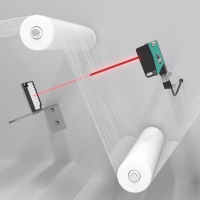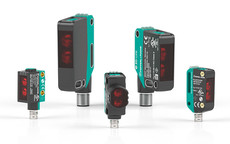Reliable Detection of Transparent PET Film in Bottling Plants
R201 Retroreflective Sensors with Polarization Filter Provide Reliable Detection

The Application
Photoelectric sensors are used for a variety of complex tasks in packaging systems. One example is high-output bottling plants that fill and seal tens of thousands of bottles every hour. The next process step, the secondary packaging, involves bundling together a set number ofindividual bottles into a container for retail—i.e. six-packs of bottles that are packaged with heat-shrink PET film.
The Goal
The technical challenge lies in ensuring uninterrupted feed of the transparent film into the shrinking unit. If a tear in the film is detected too late when the bottling plant is running at a high throughput speed, the result may be a batch with a large number of incorrectly packaged containers. These containers may then come apart during transport or when stocking shelves in the retail environment. So sensors must ensure reliability when detecting the transparent material.
The Solution

The depolarizing effect significantly improves detection reliability.
Pepperl+Fuchs has developed an extremely reliable procedure for detecting transparent objects. The sensor system consists of a R201 series retroreflective sensor and a reflector with an integrated circular polarization filter. The system uses the depolarizing effect that is generated when the emitted light passes through the film to significantly improve detection reliability. This ensures reliable presence monitoring of the transparent stretch film when it enters the shrink unit—reducing the risk of incorrect packaging.
The Benefits
The combination of R201 series retroreflective sensors and reflectors with circular polarization filter enables reliable detection of both transparent and reflective objects. During operation, the optical system works with no loss of performance, enabling the best possible operating distances and functional reserve. The procedure for detection of transparent objects is available in the R200 series and the medium-sized R201 series for larger operating distances, as well as in the R100, R101, and R103 series for space-restricted applications. This makes selecting a sensor less complicated. In addition, all five series offer the same sensing modes and one user interface.
At a Glance
- Sensor system consisting of a retroreflective sensor and a reflector with circular polarization filter
- Reliable detection of transparent objects
- Featuring IO-Link and Smart Sensor Profile for Sensorik4.0® solutions
- Smooth processes
- All photoelectric sensing modes in five standard housings for maximum flexibility and a variety of integration possibilities









 +1 330 425-3555
+1 330 425-3555